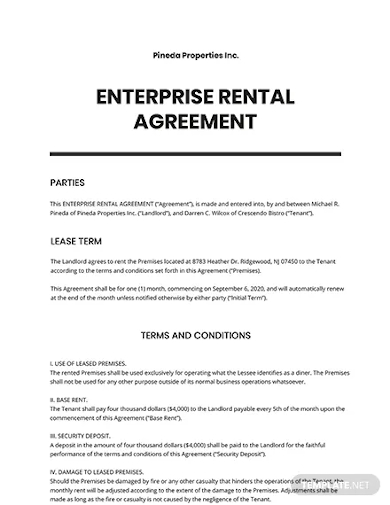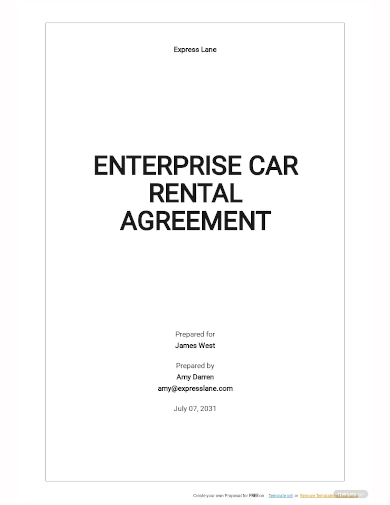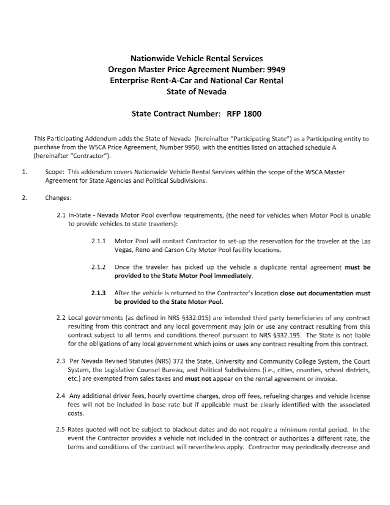If you have a spare property or building that you currently have no use for. Especially one that has a great potential for a business. The best thing to do here is to take advantage of whatever demand there is in the area and establish a good business venture. That’s simply how business works, gauge the demand of the site and try to take advantage of it for your business. However, you may not have the time nor resources to do so. Maybe you have some prior engagements that need attending to or maybe you already have another business that you have to take care of. In this case, the second best thing to do is to rent or lease your property to a prospective client or tenant. In this setting, they can establish their own business enterprise, while you are still raking in the cash from the rental payments. To make sure that you and your client or the tenant of your property is on the same page regarding the provisions of the whole duration of the rental, you’ll need to draft an enterprise rental agreement.
As a landlord or a property owner, it is imperative that you draft an enterprise rental agreement if you are planning to rent your property or establishment. Rental agreements protect your rights as a property owner and the welfare of your property itself. For example, if ever you and your client come across a legal issue, you will have a more favorable outcome in the court of law if you have a written agreement on hand. The document ensures that whatever your client is doing in your property, it is well within the scope of the provisions and what the both parties have agreed to. It saves you a lot of money and a whole lot of trouble by steering you away from disaster. There have been some pretty strange cases of landlords being cheated away from their own properties just because they lack the sufficient documentation needed to defend themselves in a legal process.
That is why before any business should be accomplished, it’s important to have a rental agreement that both parties have agreed to and will ultimately uphold. To draft this document properly, you’ll have to make sure that you have a perfect understanding of what it is and how it works. Check out these enterprise agreement samples that we have listed for you down below. Once you’ve gotten yourself well acquainted with the document, feel free to use these samples as guides or even as templates for your own enterprise rental agreement.
3+ Enterprise Rental Agreement Samples
1. Enterprise Rental Agreement Template

2. Enterprise Car Rental Agreement Template

3. Enterprise Vehicle Rental Agreement
4. Business Enterprise Rental Agreement
What Is an Enterprise Rental Agreement?
An enterprise rental agreement is a document that serves as a contract between the landlord or the owner of the property and the client or tenant. It defines the terms of the tenancy and the rules and regulations that will be in place for the whole duration of the rent or lease. Writing a rental agreement gives you a bit of your own freedom since you’ll essentially just be talking about your property overall. A lot of rental agreements are short term, usually in place for around 30 days. While leasing agreements typically last for more than a year. A rental agreement is a very useful tool especially in making sure that your client who will use the property is reliable enough to not cause any trouble or any physical damages to the property itself. Rental agreements are also just slightly better than leasing agreements since the short span of the agreement enables both parties to terminate it with relative ease.
How to Write an Enterprise Rental Agreement
A rental agreement has to include specific provisions to make sure that the document does its job of protecting you and your property. It’s fairly usual for property owners to have this document be drafted by their attorneys for themselves. More specific provisions may be included, depending on the scale of your property or the whole nature of the agreement. Regardless of its overall shape and form, a rental agreement should include at least the following.
- Identify the parties to the agreement and the address of your property
Make sure that you are listing down the names of your clients that will be using your property and provide them your details as well. Include all of your names, the address of the property, and its description. - The term of the rental and how it ends
State how long the whole rental agreement will last for and make sure that they understand it. Start the term on the first of the month, and include how much time should be allocated for the notice you or your client should provide if either of you decides to terminate the agreement. - Rent and security deposit
Include the exact amount of how much the monthly rent is, state where the tenant should pay and how the payment process if going to be. Whether you accept cash or card, checks, or virtual banking and payments. If you want your client to send a check every month, be sure to include the mailing address. Also the interest of the payment if there are any late fees, but make sure that these are not excessive. - What comes with the rental
State whether or not the rental comes with amenities and utilities. Electricity, heat, gas, cable, etc. If not, then state the client’s responsibilities for the utilities. Give a clear description of the components that are included in the rent and what is not. IF you are providing furniture and appliances, state them by their names. - Pets
Inform them if pets are allowed into the establishment and its corresponding provisions. You can choose to have a not-pet policy, make sure that you state that in your agreement. - Each occupant’s name and the total number of occupants
If you don’t want additional people in your property other than the client themselves, inform them so. List the names of the occupants who are allowed inside the property and who will be accommodated. - Landlord’s access to the property for repairs, maintenance, and routine inspections
Be clear and concise with the notices that you will be sending out prior to your repair or maintenance visit, other than for emergencies. Some local communities have their own requirements per property or building, while some states have consistent requirements all throughout. - Rules of the rental
List the things that you expect your tenant to not do. Illegal activities, smoking on site, and closing time in a particular time of day or night. Inform them how you’ll terminate the agreement if the client fails to follow the rules and the provisions that you have provided. - Damaged property
Inform how the client is responsible for the damages other than the property just wearing down. The client must also be able to turn over the property in its original condition when it was leased. - Signatures
After all has been said and done, both you and your client should sign the document for binding. If you want full legality, you can also have it signed by your attorneys of the local public notary.
FAQs
What are the types of rental agreements?
- Fixed-term leases
- Automatic renewal leases
- Month to month lease agreements
- Standard residential rental lease agreements
- Short-term or vacation rental agreements
- Sublease agreements
- Room rental agreements
- Commercial lease agreements
And a lot more.
How long is a lease good for?
The most common term for a lease in one year, however it is normal for leases to last for far longer.
Who pays the rent agreement?
Generally, the tenant bears the costs associated with the entire rental agreement.
Renting your property can bring its own fair share of risks. Most more compelling than others. However, as long as you have a well drafted rental agreement, with the elements we’ve listed above, you’ll be protecting yourself from a world of trouble.
Related Posts
Sample Business Agreement between Two Parties
FREE 9+ Shop Rental Agreement Samples [ Commercial, Lease, Tenancy ]
FREE 10+ Charter Agreement Samples In MS Word | Google Docs | Apple Pages | PDF
FREE 10+ Mentoring Agreement Samples In MS Word | Apple Pages | PDF
FREE 10+ Partner Agreement Samples In MS Word | Google Docs | Apple Pages | PDF
FREE 10+ Individual Agreement Samples In MS Word | Google Docs | Apple Pages | PDF
FREE 10+ Strategic Agreement Samples In MS Word | Google Docs | Apple Pages | PDF
FREE 10+ Equity Agreement Samples In MS Word | Google Docs | Apple Pages | PDF
FREE 10+ Producer Agreement Samples in MS Word | Apple Pages | PDF
FREE 10+ Grant Agreement Samples In MS Word | Apple Pages | PDF
FREE 8+ Meeting Agreement Samples in MS Word | Google Docs | Apple Pages | PDF
FREE 10+ Community Agreement Samples In MS Word | Google Docs | PDF
FREE 8+ Real Estate Option Agreement Samples in MS Word | PDF
FREE 10+ Call Option Agreement Samples In MS Word | PDF
FREE 10+ Advertising Agreement Samples In MS Word | Google Docs | Apple Pages | PDF


